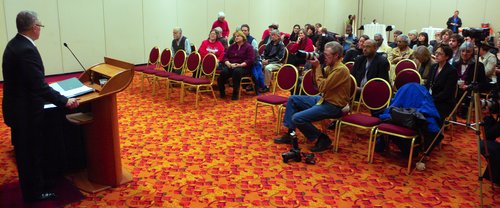A provocative title for a must read. It addresses a number of issues, from local outsize influence on school boards to Wisconsin’s low state standards:
Congress erred big-time when NCLB assigned each state to set its own standards and devise and score its own tests … this study underscores the folly of a big modern nation, worried about its global competitiveness, nodding with approval as Wisconsin sets its eighth-grade reading passing level at the 14th percentile while South Carolina sets its at the 71st percentile.
Matt Miller via a kind reader’s email:
It wasn’t just the slate and pencil on every desk, or the absence of daily beatings. As Horace Mann sat in a Leipzig classroom in the summer of 1843, it was the entire Prussian system of schools that impressed him. Mann was six years into the work as Massachusetts secretary of education that would earn him lasting fame as the “father of public education.” He had sailed from Boston to England several weeks earlier with his new wife, combining a European honeymoon with educational fact-finding. In England, the couple had been startled by the luxury and refinement of the upper classes, which exceeded anything they had seen in America and stood in stark contrast to the poverty and ignorance of the masses. If the United States was to avoid this awful chasm and the social upheaval it seemed sure to create, he thought, education was the answer. Now he was seeing firsthand the Prussian schools that were the talk of reformers on both sides of the Atlantic.
In Massachusetts, Mann’s vision of “common schools,” publicly funded and attended by all, represented an inspiring democratic advance over the state’s hodgepodge of privately funded and charity schools. But beyond using the bully pulpit, Mann had little power to make his vision a reality. Prussia, by contrast, had a system designed from the center. School attendance was compulsory. Teachers were trained at national institutes with the same care that went into training military officers. Their enthusiasm for their subjects was contagious, and their devotion to students evoked reciprocal affection and respect, making Boston’s routine resort to classroom whippings seem barbaric.
Mann also admired Prussia’s rigorous national curriculum and tests. The results spoke for themselves: illiteracy had been vanquished. To be sure, Prussian schools sought to create obedient subjects of the kaiser—hardly Mann’s aim. Yet the lessons were undeniable, and Mann returned home determined to share what he had seen. In the seventh of his legendary “Annual Reports” on education to the Commonwealth of Massachusetts, he touted the benefits of a national system and cautioned against the “calamities which result … from leaving this most important of all the functions of a government to chance.”
Mann’s epiphany that summer put him on the wrong side of America’s tradition of radical localism when it came to schools. And although his efforts in the years that followed made Massachusetts a model for taxpayer-funded schools and state-sponsored teacher training, the obsession with local control—not incidentally, an almost uniquely American obsession—still dominates U.S. education to this day. For much of the 150 or so years between Mann’s era and now, the system served us adequately: during that time, we extended more schooling to more people than any nation had before and rose to superpower status. But let’s look at what local control gives us today, in the “flat” world in which our students will have to compete.
The United States spends more than nearly every other nation on schools, but out of 29 developed countries in a 2003 assessment, we ranked 24th in math and in problem-solving, 18th in science, and 15th in reading. Half of all black and Latino students in the U.S. don’t graduate on time (or ever) from high school. As of 2005, about 70 percent of eighth-graders were not proficient in reading. By the end of eighth grade, what passes for a math curriculum in America is two years behind that of other countries.
Dismal fact after dismal fact; by now, they are hardly news. But in the 25 years since the landmark report A Nation at Risk sounded the alarm about our educational mediocrity, America’s response has been scattershot and ineffective, orchestrated mainly by some 15,000 school districts acting alone, with help more recently from the states. It’s as if after Pearl Harbor, FDR had suggested we prepare for war through the uncoordinated efforts of thousands of small factories; they’d know what kinds of planes and tanks were needed, right?
When you look at what local control of education has wrought, the conclusion is inescapable: we must carry Mann’s insights to their logical end and nationalize our schools, to some degree. But before delving into the details of why and how, let’s back up for a moment and consider what brought us to this pass.
Related:
